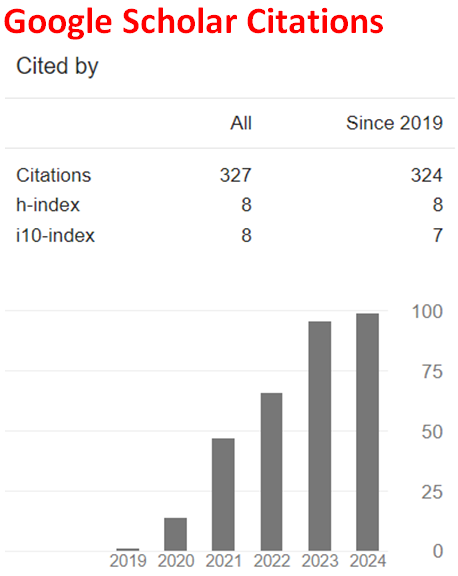Neutral and Charged Nitrophenyl-N-methylnitramines - A DFT Treatment
Abstract
In the present density functional study neutral and positively charged (mono and dication forms) nitrophenyl-N-methylnitramines have been considered within the constraints of the theory and the basis set employed. Depending on the closed and open-shell nature of the systems considered, B3LYP/6-31++G(d,p) and UB3LYP/6-31++G(d,p) level of theories have been adopted, respectively. Some quantum chemical properties of those neutral and cationic systems have been obtained and discussed. The neutral and monocation systems are found to have exothermic heat of formation values and favorable Gibbs free energy of formations at the standard state. All the neutral systems and the monocations, except just one case, are electronically stable. In the ortho monocation case nitramine group decomposes by releasing the nitro moiety. Whereas, all the dication systems considered undergo similar type decomposition. In all the neutral systems, the nitro group of nitramine moiety possesses some minute negative partial charge, but in the monocation systems it has some positive partial charge (decomposed or not). In contrast, the dication forms, release nitramine NO2 moiety which carries positive formal charge.
References
Borges Jr., I. (2008). Excited electronic and ionized states of N,N-dimethylnitramine. Chemical Physics, 349, 256-262.
Shu, Y., Korsounskii, B.L., & Nazina, G.M. (2004). The mechanism of thermal decomposition of secondary nitramines. Russ. Chem. Rev., 73, 293-307. https://doi.org/10.1070/RC2004v073n03ABEH000802
Yan, Q-L., Zeman, S., & Elbeih, A. (2013). Thermal behavior and decomposition kinetics of Viton A bonded explosives containing attractive cyclic nitramines. Thermochimica Acta, 562, 56-64. https://doi.org/10.1016/j.tca.2013.03.041
Zhang, J., He, C., Parrish, D.A., & Shreeve, J.M. (2013). Nitramines with varying sensitivities: functionalized dipyrazolyl-N-nitromethanamines as energetic materials. Chemistry, A European Journal, 19(27), 8929-8936. https://doi.org/10.1002/chem.201300747
Oxley, J.C., Hiskey, M., Naud, D., & Szekeres, R. (1992). Thermal decomposition of nitramines: dimethylnitramine, diisopropylnitramine, and N-nitropiperidine. The Journal of Physical Chemistry, 96(6), 2505-2509. https://doi.org/10.1021/j100185a023
Keshavarz, M.H. (2009). Simple method for prediction of activation energies of the thermal decomposition of nitramines. Journal of Hazardous Materials, 162(2-3), 1557-1562. https://doi.org/10.1016/j.jhazmat.2008.06.049
Shishkov, I.F., Vilkov, L.V., Kolonits, M., & Rozsondai, B. (1991). The molecular geometries of some cyclic nitramines in the gas phase. Struct. Chem., 2, 57-64. https://doi.org/10.1007/BF00673490
Ermolin, N.E., & Zarko, V.E. (1998). Modeling of cyclic-nitramine combustion. Combust. Explos. Shock Waves, 34, 485-501. https://doi.org/10.1007/BF02672671
Gribov, P.S., Suponitsky, K.Yu., & Sheremetev, A.B. (2022). Efficient synthesis of N-(chloromethyl)nitramines via TiCl4-catalyzed chlorodeacetoxylation. New J. Chem., 46, 17548-17553. https://doi.org/10.1039/D2NJ03521A
Elbasuney, S., Yehia, M., Hamed, A., Ismael, S., & El Gamal, M. (2021). Ferric oxide colloid: novel nanocatalyst for heterocyclic nitramines. J Mater Sci: Mater Electron, 32, 4185–4195. https://doi.org/10.1007/s10854-020-05162-0
Patil, V.B., Zalewski, K., Schuster, J., Bělina, P., Trzciński, W.A., & Zeman, S. (2021). A new insight into the energetic co-agglomerate structures of attractive nitramines. Chemical Engineering Journal, 420, 130472. https://doi.org/10.1016/j.cej.2021.130472
Vinogradov, D.B., Bulatov, P.V., Petrov, E. Yu., & Tartakovsky, V.A. (2021). New access to azido-substituted alkylnitramines. Mendeleev Communications, 31(6), 795-796. https://doi.org/10.1016/j.mencom.2021.11.008
Türker, L. (2020). Some novel tricyclic caged-nitramines - A DFT Study. Earthline Journal of Chemical Sciences, 5(1), 35-48. https://doi.org/10.34198/ejcs.5121.3548
Türker, L. (2009). Contemplation on spark sensitivity of certain nitramine type explosives. Journal of Hazardous Materials, 169(1-3), 454-459. https://doi.org/10.1016/j.jhazmat.2009.03.117
Türker, L. (2019). Nitramine derivatives of NTO - A DFT study. Earthline Journal of Chemical Sciences, 1(1), 45-63. https://doi.org/10.34198/ejcs.1119.4563
Meyer, R., Köhler, J., & Homburg, A. (2002). Explosives. Weinheim: Wiley-VCH.
Türker, L. (2017). Effect of an alpha-particle on Tetryl - A DFT study. Int. J. of Chemical Modeling, 9(1), 27-36.
Türker, L. (2015). Modeling of effect of primary cosmic rays on Tetryl-A DFT study. Int. J. of Chemical Modeling, 7(2), 133-143.
Stewart, J.J.P. (1989). Optimization of parameters for semi empirical methods I. J. Comput. Chem., 10, 209-220. https://doi.org/10.1002/jcc.540100208
Stewart, J.J.P. (1989). Optimization of parameters for semi empirical methods II. J. Comput. Chem., 10, 221-264. https://doi.org/10.1002/jcc.540100209
Leach, A.R. (1997). Molecular modeling. Essex: Longman.
Kohn, W., & Sham, L.J. (1965). Self-consistent equations including exchange and correlation effects. Phys. Rev., 140, 1133-1138. https://doi.org/10.1103/PhysRev.140.A1133
Parr, R.G., & Yang, W. (1989). Density functional theory of atoms and molecules. London: Oxford University Press.
Becke, A.D. (1988). Density-functional exchange-energy approximation with correct asymptotic behavior. Phys. Rev. A, 38, 3098-3100. https://doi.org/10.1103/PhysRevA.38.3098
Vosko, S.H., Wilk, L., & Nusair, M. (1980). Accurate spin-dependent electron liquid correlation energies for local spin density calculations: a critical analysis. Can. J. Phys., 58, 1200-1211. https://doi.org/10.1139/p80-159
Lee, C., Yang, W., & Parr, R.G. (1988). Development of the Colle-Salvetti correlation energy formula into a functional of the electron density. Phys. Rev. B, 37, 785-789. https://doi.org/10.1103/PhysRevB.37.785
SPARTAN 06 (2006). Wavefunction Inc. Irvine CA, USA.
Fleming, I. (1976). Frontier orbitals and organic reactions. London: Wiley.
Hehre, W.J., Shusterman, A.J., & Huang, W.W. (1998). A laboratory book of computational organic chemistry. Irvine, CA: Wavefunction.

This work is licensed under a Creative Commons Attribution 4.0 International License.


